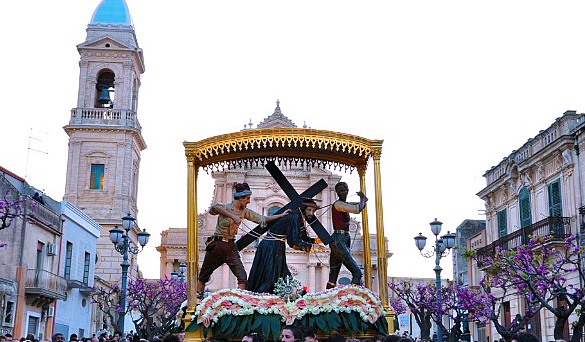The week before Easter known as Holy Week, is one of the most sacred times of year for Catholics everywhere. In Italy, this solemn time is called La Settimana Santa and is marked with ancient processions that commemorate the passion, death and resurrection of Jesus Christ. People from around the world travel to Italy to take part in these elaborate, deeply moving religious ceremonies. Italians celebrate the days of La Settimana Santa with various rituals that are a rich blend of faith, folklore, tradition and community.
La Domenica delle Palme (Palm Sunday)
Palm Sunday, or La Domenica delle Palme, marks the beginning of Holy Week. In towns throughout Italy, worshipers carry crosses made from palm fronds and olive branches as they return from church. Since olive trees are more abundant than palm trees, they are far more common than palms on La Domenica delle Palme. Occasionally, priests carry finely woven palm fronds, but most Italians carry olive branches that are handed out at the entrance to the church.
Lunedì Santo (Holy Monday)
On Lunedì Santo, or Holy Monday, a large celebration takes place in Castelsardo, a Sardinian town famous for its elaborate Holy Week celebrations. The faithful mark the day with a ritual called Lunissanti, which begins at dawn and continues through the night. Wearing capes, leather belts and hoods, members of the Confraternita di S. Croce, or Brotherhood of the Holy Cross, assemble at the Holy Maria of Tergu Church, where rites and religious ceremonies are celebrated. When the sun rises, the Mass ends and the procession begins.
Martedì Santo (Holy Tuesday)
In the Sardinian village of Iglesias, the first Holy Week activity takes place on Martedì Santo with the procession of “The Mysteries.” Seven statues representing various moments of the Passion of Christ are carried around the city streets. A small chair decorated with flowers and olive branches symbolizing the Garden of Gethsemane is followed by Christ imprisoned, Christ scourged, Christ crowned with thorns, Christ walking towards Calvary, Christ crucified and finally, the image of the Madonna Addolorata.
Giovedì Santo (Holy Thursday)
Across Italy, devotees gather in the late afternoon or early evening of Giovedì Santo, Holy Thursday, for the Mass of the Last Supper. In a gesture of humility, priests, bishops and even the Pope himself, recreate Christ’s bathing of the feet of the Apostles by washing the feet of twelve parishioners.
On Holy Thursday, all church bells, including handheld altar bells, are silenced across Italy until the Easter Vigil Mass on Holy Saturday.
In the region of Puglia, a Holy Thursday procession takes place in Taranto known as the Addolorata, or Our Lady of Sorrows. Beginning at midnight, it follows a long route through the town, returning the following afternoon. At five o’clock on Good Friday, the procession sets out from the Church of St. Mary of Carmel and returns the next morning after another long pilgrimage. The pilgrims, called perdoni, walk bare-footed and cover their faces with hoods. The slow and prolonged march covers about 100 feet per hour.
Venerdì Santo (Good Friday)
In Sorrento on the Amalfi Coast, there are two Good Friday processions – the white procession in the morning, with participants wearing white, symbolic of Mary’s hope as she searches for her son and the second, a black procession in the evening, where black represents Mary’s sorrow as she beholds her son’s lifeless body.
In Sicily, the town of Enna has more than 2,000 friars dressed in ancient costumes as they march through the streets, while in Ispica, the processions begin on Holy Thursday with U Patri a Culonna – Christ tied at the column. This includes a parade of the Confrati of Santa Maria Maggiore, wearing traditional red vests. On this day, is U Patri a Cruci – Christ carrying the cross, with a parade of the Confrati of the Annunziata Church wearing blue vests. On Easter Sunday, the two confraternite are reunited for the procession of the Risuscitatu – Christ Resurrected, with the meeting between the statues of Jesus and the Virgin Mary.
In Sardinia, the Holy Week rituals in Alghero – Setmana Santa de l’Alguer, are among the most striking. Easter traditions date back to the 16th century and are still organized by the Confraternita della Misericordia (the Brotherhood of Misericordia). The focus of all the rituals is the Santcristus wooden statue of Christ. In the care of the Brotherhood of Gonafalone in the Church of Misericordia, the statue landed in Alghero in 1606, during the shipwreck of the Santa Maria di Montenero that was heading to Genoa. The wooden Christ of Alicante, Santcristus floated ashore and became the most representative symbol of the town. The first procession in Alghero begins on Good Friday. Traditionally, women dressed in black follow the statue of the Blessed Virgin Mary through the town.
Sabato Santo (Holy Saturday)
Sabato Santo, Holy Saturday, is a day of silence and prayer in honor of the dead Christ. Mass is not celebrated and the tabernacle, which usually contains the blessed Communion hosts, is left empty and open. After sundown, the solemn Easter Vigil begins with the liturgy of fire and the lighting of the Easter candle, which represents the “Light of Christ.” Readings from the Gospels recount the appearance of the angels to the women who came to the tomb in search of Christ. During the liturgy of the baptism, all the faithful renew their baptismal vows.





